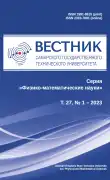Представление Лагранжа квантовой эволюции материальных полей
- Авторы: Самарин А.Ю.1, Штеренберг А.М.1
-
Учреждения:
- Самарский государственный технический университет
- Выпуск: Том 27, № 1 (2023)
- Страницы: 50-63
- Раздел: Дифференциальные уравнения и математическая физика
- URL: https://journal-vniispk.ru/1991-8615/article/view/145889
- DOI: https://doi.org/10.14498/vsgtu1953
- ID: 145889
Цитировать
Полный текст
Аннотация
Показано, что квантовый интеграл по путям может быть представлен в виде функционала единственного пути, удовлетворяющего принципу наименьшего действия (ввиду несовпадения оригинального английского понятия path и русского понятия «траектория» будет употребляться понятие «путь», которое подразумевает параметрическую зависимость координат точки от времени x(t), y(t), z(t)). На этом основании материальные поля, совокупность которых при данном подходе отождествляется с квантовой частицей, представляются в виде непрерывных множеств индивидуальных частиц, механическое движение которых определяет поля физических величин, атрибутов этих индивидуальных частиц в каждый момент времени. Волновая функция стационарного состояния при таком подходе является полем комплексной плотности индивидуальных точек. Модуль комплексной плотности представляет собой нормированную тем или иным образом плотность материи в данной точке пространства, фазовый множитель определяет результат суперпозиции материальных полей. Это позволило преобразовать интегральное уравнение квантовой эволюции к представлению Лагранжа. На примере описания квантового гармонического осциллятора продемонстрирована состоятельность такого подхода.
Об авторах
Алексей Юрьевич Самарин
Самарский государственный технический университет
Автор, ответственный за переписку.
Email: Samarinay@yahoo.ru
ORCID iD: 0000-0001-7640-3875
http://www.mathnet.ru/rus/person42489
кандидат физико-математических наук, доцент; каф. общей физики и физики нефтегазового производства
Россия, 443100, г. Самара, ул. Молодогвардейская, 244Александр Моисеевич Штеренберг
Самарский государственный технический университет
Email: asher53@yandex.ru
ORCID iD: 0000-0002-1825-0097
доктор физико-математических наук, профессор; каф. общей физики и физики нефтегазового производства
Россия, 443100, Самара, ул. Молодогвардейская, 244Список литературы
- Schrödinger E. Der stetige Übergang von der Mikro- zur Makromechanik // Naturwissenschaften, 1926. vol. 14. pp. 664–666. DOI: https://doi.org/10.1007/BF01507634.
- Bell J. Against ’measurement’ // Physics World, 1990. vol. 3, no. 8. pp. 33–40. DOI: https://doi.org/10.1088/2058-7058/3/8/26.
- Einstein A., Podolsky B., Rosen N. Can quantum-mechanical description of physical reality be considered complete? // Phys. Rev., 1935. vol. 47, no. 10. pp. 777–780 10.1103/PhysRev.47.777.
- Samarin A. Yu. Nonlinear dynamics of open quantum systems // Vestn. Samar. Gos. Tekhn. Univ., Ser. Fiz.-Mat. Nauki [J. Samara State Tech. Univ., Ser. Phys. Math. Sci.], 2018. vol. 22, no. 2. pp. 214–224. EDN: XWXSKT. DOI: https://doi.org/10.14498/vsgtu1582.
- Clauser J. F., Horne M. A., Shimony A., Holt R. A. Proposed experiment to test local hidden-variable theories // Phys. Rev. Lett., 1969. vol. 23, no. 15. pp. 880–883. DOI: https://doi.org/10.1103/PhysRevLett.23.880.
- Freedman S. J., Clauser J. F. Experimental test of local hidden-variable theories // Phys. Rev. Lett., 1972. vol. 28, no. 14. pp. 938–941. DOI: https://doi.org/10.1103/PhysRevLett.28.938.
- Aspect A., Grangier P., Roger G. Experimental realization of Einstein–Podolsky–Rosen–Bohm Gedankenexperiment: A new violation of Bell’s inequalities // Phys. Rev. Lett., 1982. vol. 49, no. 2. pp. 91–94 10.1103/PhysRevLett.49.91.
- Feynman R. P. Space-time approach to non-relativistic quantum mechanics // Rev. Mod. Phys., 1948 10.1103/RevModPhys.20.367. vol. 20, no. 2. pp. 367–387.
- Feynman R. P., Hibbs A. R. Quantum Mechanics and Path Integrals. Mineola, NY: Dover Publ., 2010. xii+371 pp.
- Zinn-Justin J. Path Integrals in Quantum Mechanics. Oxford: Oxford Univ. Press, 2005. xiii+318 pp.
- Samarin A. Yu. Quantum evolution in terms of mechanical motion // Vestn. Samar. Gos. Tekhn. Univ., Ser. Fiz.-Mat. Nauki [J. Samara State Tech. Univ., Ser. Phys. Math. Sci.], 2021. vol. 25, no. 2. pp. 393–401. EDN: LIZMMB. DOI: https://doi.org/10.14498/vsgtu1851.
- Samarin A. Yu. Quantum evolution as a usual mechanical motion of peculiar continua // Vestn. Samar. Gos. Tekhn. Univ., Ser. Fiz.-Mat. Nauki [J. Samara State Tech. Univ., Ser. Phys. Math. Sci.], 2020. vol. 24, no. 1. pp. 7–21. EDN: LIZMMB. DOI: https://doi.org/10.14498/vsgtu1724.
- MacColl L. A. Note on the transmission and reflection of wave packets by potential barriers // Phys. Rev., 1932. vol. 40, no. 4. pp. 621–626. DOI: https://doi.org/10.1103/PhysRev.40.621.
- Hartman T. E. Tunneling of a wave packet // J. Appl. Phys., 1962. vol. 33, no. 12. pp. 3427–3433. DOI: https://doi.org/10.1063/1.1702424.
- Steinberg A. M. How much time does a tunneling particle spend in the barrier region? // Phys. Rev. Lett., 1995. vol. 74, no. 13. pp. 2405–2409. DOI: https://doi.org/10.1103/PhysRevLett.74.2405.
- Kac M. Probability and Related Topics in Physical Sciences. New York: Interscience Publ., 1959. xiii+266 pp.
Дополнительные файлы






